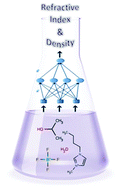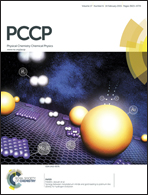The accurate estimation of physicochemical properties of ternary mixtures containing ionic liquids via artificial neural networks†
Abstract
The estimation of the density and refractive index of ternary mixtures comprising the ionic liquid (IL) 1-butyl-3-methylimidazolium tetrafluoroborate, 2-propanol, and water at a fixed temperature of 298.15 K has been attempted through artificial neural networks. The obtained results indicate that the selection of this mathematical approach was a well-suited option. The mean prediction errors obtained, after simulating with a dataset never involved in the training process of the model, were 0.050% and 0.227% for refractive index and density estimation, respectively. These accurate results, which have been attained only using the composition of the dissolutions (mass fractions), imply that, most likely, ternary mixtures similar to the one analyzed, can be easily evaluated utilizing this algorithmic tool. In addition, different chemical processes involving ILs can be monitored precisely, and furthermore, the purity of the compounds in the studied mixtures can be indirectly assessed thanks to the high accuracy of the model.


 Please wait while we load your content...
Please wait while we load your content...